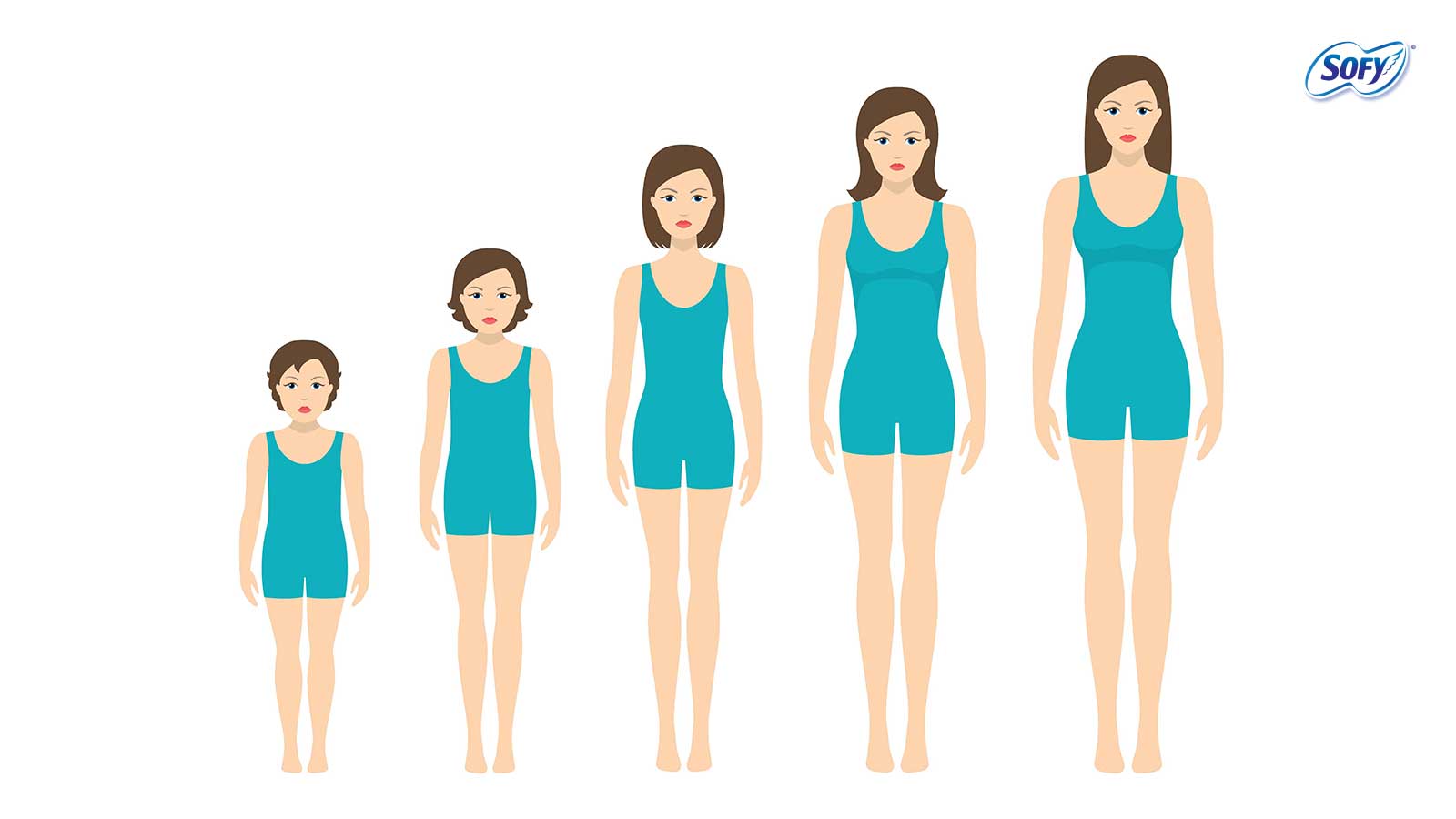Puberty is a major milestone in any girl’s life. Girls usually get a few inches taller, more mature and start blossoming into young women. It is a mixed bag of experiences. Puberty is the biological phase that marks the transformation of the body from the juvenile to the adult stage. It is a time when the body matures and develops the characteristics required for sexual reproduction.
• Body Growth: There is a rapid increase in height and weight due to a growth spurt that causes bone growth. Weight increases corresponding to the increase in bone size and the new deposits of fat on the body.
• Breasts Development: The first ever change in women when they hit puberty are the development of their breasts. After the age of 12-13, girls attain their puberty and their internal structure of breasts begin to due to the hormones, mainly estrogen and progesterone. Later, Growth hormone and glucocorticoids complete the process of development. The hormones enhance the breasts with building the network of ducts within the breasts and fatty and fibrous tissues enlarge the breasts. Girls have to wear a bra to give support to their breasts.
• Body Hair: As soon as girls attain puberty, they’d start having hair growth on various parts of their body ie underarms, lower stomach, and pubic area. The hair that grows on these areas is usually curly. Body hair is absolutely normal and is only there to protect the sensitive areas of your body from bacteria, germs, etc.
• Body Sweat: One thing that also increases when girls attain puberty are the sweat glands. They become larger and more active. So when girls attain puberty, they tend to sweat more. Girls can officially wear antiperspirants/ deodorant to help reduce sweating.
• Genital Development: As soon as girls attain puberty, the genitals also start to grow and change. The outside parts (vulva) are enclosed by the two sets of “lips”. The larger lips have hair; the inner, smaller lips don’t. These increase in size a little bit. You can’t see it, but inside your body, your vagina is getting longer and the uterus is getting bigger.
• Discharge: Usually, there is a yellow or white stain known as discharge which starts to happen when girls attain their puberty. The fluid that is discharged from the body is absolutely normal as it naturally moistens and cleanses out the vagina.
• Menstruation: Yes! Menstruation starts when girls attain puberty which is usually around 12-14 years. The first menstrual period is also known menarche which basically marks the ends of a girl’s puberty. For the first two years, the menstrual cycle is unpredictable as it takes 1-2 years for the menstrual cycle to develop. Hormones cause your ovaries to release one egg about once a month. Most months, the egg and the lining of the uterus come out of your vagina as your periods. The menstrual cycle is what makes it possible for a woman to conceive a baby.
FAQ’s
2. At what age does puberty typically start for girls?
Puberty in girls typically begins between the ages of 8 and 13, but it can start earlier or later depending on individual factors such as genetics, nutrition, and overall health. The onset of puberty varies for each girl.
3. What are the main stages of puberty in girls?
The main stages of puberty in girls include:
- Stage 1: Pre-puberty, where the body shows no visible signs of development.
- Stage 2: Early signs like breast budding and the growth of pubic hair begin.
- Stage 3: Continued breast development, increased growth of pubic hair, and the onset of a growth spurt.
- Stage 4: Menstruation begins, and other secondary sexual characteristics, such as underarm hair, develop.
- Stage 5: Full maturation, where most pubertal changes have completed, and the body reaches adult form.
4. What is breast budding, and when does it occur?
Breast budding is the first noticeable sign of puberty in girls, where small, firm lumps form under the nipples. It usually occurs between the ages of 8 and 13 and marks the beginning of breast development.
5. How does pubic hair growth signify puberty in girls?
Pubic hair growth is a key sign of puberty and typically follows breast budding. It begins as fine, light hair and becomes coarser and darker over time, eventually covering the pubic area.
6. When do girls typically experience their first menstrual period?
Girls typically experience their first menstrual period, known as menarche, between the ages of 9 and 15, usually around two years after breast development begins. Menarche signifies that the body is capable of reproduction.
7. What emotional changes do girls experience during puberty?
During puberty, girls may experience emotional changes such as mood swings, increased sensitivity, and heightened emotional responses due to fluctuating hormone levels. These changes are normal and part of the maturation process.
8. How does puberty affect a girl's growth?
Puberty triggers a rapid growth spurt in girls, usually beginning between the ages of 10 and 14. This growth spurt involves an increase in height and weight, with most girls reaching their adult height by the end of puberty.
9. What changes occur in the skin and hair during puberty?
During puberty, increased hormone production can lead to changes in the skin, such as acne or oily skin. Hair growth becomes thicker and more noticeable, particularly in the underarms and pubic areas, and scalp hair may become oilier.
10. How can parents support their daughters through puberty?
Parents can support their daughters by providing accurate information about puberty, maintaining open communication, offering reassurance, and ensuring access to appropriate hygiene products. Encouraging a healthy lifestyle, including balanced nutrition and exercise, also helps girls navigate the changes of puberty.












